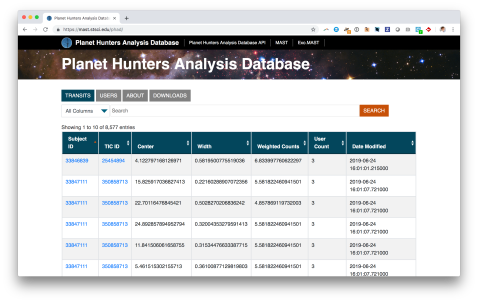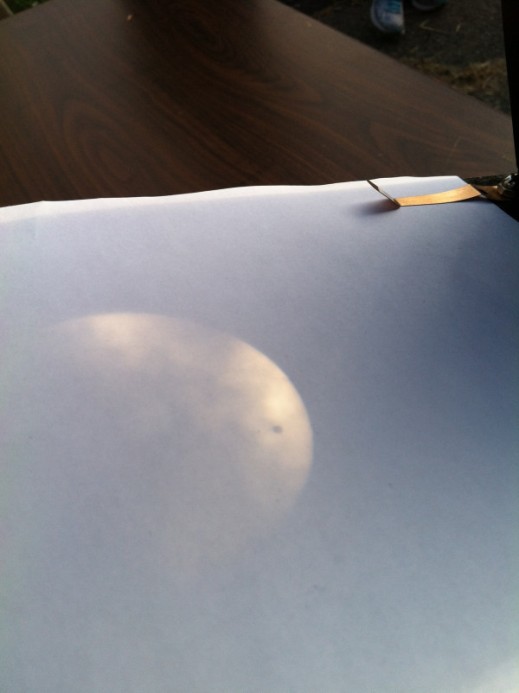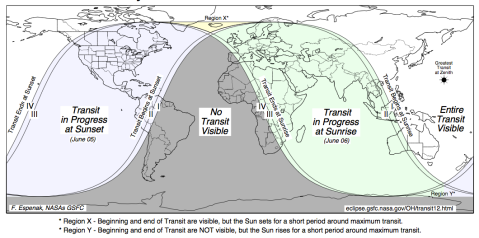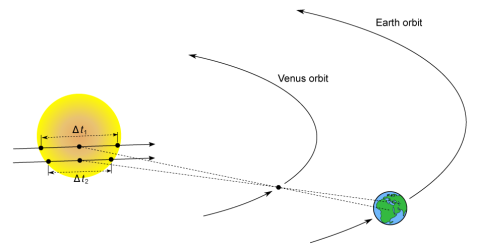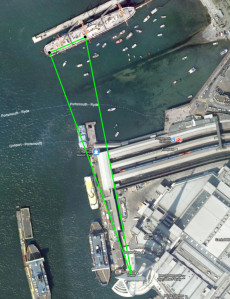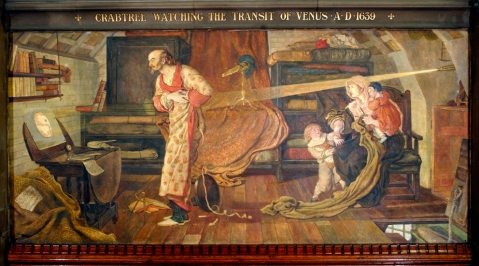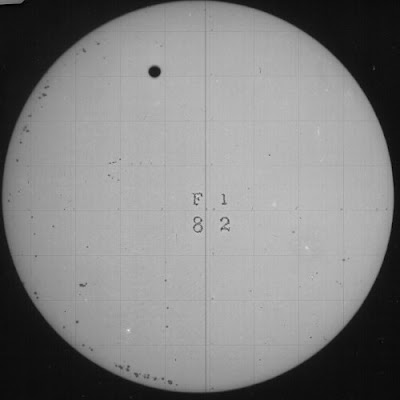Planet Hunters: TESS results now on MAST
Since Planet Hunters launched in 2010, we’ve made all sorts of interesting discoveries, but apart from the occasional blog posted here you’ve had to wait until we’ve written them up in peer reviewed papers to hear about them. Such formal publication is important – it’s how information gets written into the scientific record, and how credit is recorded – but it’s slow, and this can be frustrating. It’s especially frustrating for volunteers who think they’ve found something and who then have to wait years for us to get around to doing the work required to turn a ‘maybe’ into a candidate worth publishing.
For TESS, we wanted to do something a bit different. Once candidates have been vetted they can be posted to exoFOP, where the astronomical community coordinates follow-up, but it takes quite a lot of work to get to that point.
We want to share your discoveries as quickly as possible, so today we’ve switched on a system that analyses your classifications as they come in, and when a potential planet is detected passes this information immediately to the archive which hosts TESS data, MAST. (MAST is run by a team at the Space Telescope Science Institute in Baltimore, including original Zooniverse technical lead Arfon Smith).
This means that anyone can access the latest Planet Hunters data via the Planet Hunters Analysis Database – and from there go on to explore the rest of the data that might exist about the host stars and system. Volunteers get to see their results almost instantly (and get their name in an official NASA archive!), and scientists will be able to use this data to identify possible planets that they can follow up, and give credit to the citizen scientists when they do – so hopefully this new strategy will result in more Planet Hunters planets making it into the literature.
We can run Planet Hunters because the TESS team are being open with their data. We hope that being equally open with our data will encourage more people to get involved so we can find even more planets. Go see if your name is already up in lights at https://mast.stsci.edu/phad/, or get classifying to contribute to the results at www.planethunters.org!
PS The MAST team provide a set of Jupyter notebooks which support TESS data analysis. If you know a little Python, or are willing to learn, then you can get quite a long way analysing your own candidates! Get started at https://github.com/zooniverse/phad-notebook.
Hot Friends of Hot Jupiters: The WASP-47 system
Ever since a mechanical failure caused the end of the original Kepler mission in 2013, the Kepler spacecraft has been conducting a survey of new stars, searching for planets across the ecliptic plane in its new K2 mission (https://blog.planethunters.org/2014/12/12/more-about-the-k2-campaign-0/). The K2 dataset is a goldmine of fascinating science results. One such result is the recent discovery of two new planets in the WASP-47 system.
Until a few months ago, everyone knew that hot Jupiter planets don’t have “friends”, or nearby small planets in close orbits to the host star. These other planets had been searched for extensively, through radial velocity measurements, analysis of the transit times of the hot Jupiters, and even through transits by Kepler during its original mission. All of these searches turned up nothing.
This all changed one day last July, when Hans Martin Schwengeler, a Planet Hunter who enjoys poring over Kepler and K2 data searching for new transiting planets by eye, came across the telltale signatures of two extra transiting planets in the hot Jupiter system WASP-47. WASP 47b was, by all indications, a perfectly normal hot Jupiter — in the discovery paper, Coel Hellier wrote “With an orbital period of 4.16 days, a mass of 1.14 Jupiter masses, and a radius of 1.15 Jupiter radii, WASP-47b is an entirely typical hot Jupiter”. The discovery of additional transiting planets dramatically changed the narrative.
When Hans came across the planets, he posted them to the Planet Hunters forum, where he and other citizen scientists discuss their findings. Andrew Vanderburg came across the post suggesting that a known hot Jupiter had planetary companions. Using his K2 data reduction pipeline (https://blog.planethunters.org/2015/01/08/a-recipe-for-making-a-k2-light-curve/), he analyzed the light curve and confirmed Hans’s discovery – there were additional planets in the system, a super-Earth at a 0.8 day period and a Neptune at a 9 day period!
Andrew emailed me, and at first I hardly believed that the lightcurve was real. How could a hot Jupiter have close-in planetary companions? I knew people had been looking for this type of companion for years via both photometry and transit timing variations, but the lack of discoveries indicated that they might not exist. I performed some numerical stability simulations (because it seemed at first like this system could not be dynamically stable!) and sure enough, the N-body simulations showed that the system was likely stable on timescales of 10 million years.
At that point, we formed a team with Hans, Andrew, MIT Professor Saul Rappaport, University of Michigan Professor Fred Adams (my advisor!), and me. Once this team was formed, we devoted ourselves to understanding as much about the systems as we could. Some work by Saul and Andrew confirmed that the planets were all orbiting the same star, Andrew fit the lightcurve to get the planet properties, and I ran more stability simulations. Soon enough, Fred suggested that I look at what transit timing variations (or TTVs, which happen when transits come late or early because of the gravity of other planets in the system) we would theoretically expect to see from the system – and I found that for the outer two planets, the TTVs should be observable.
I then measured the TTVs from the lightcurve, and sure enough – there was something there. After some discussion, we realized we could measure the masses of the planets from those TTVs! Though I had never done dynamical fits before, I wrote the code to utilize Kat Deck’s TTVFAST code in a Markov Chain Monte Carlo fit. With some advice from Kat and help from Fred, I eventually got the fits working and we were able to measure or put limits on the masses of each planet.
In a little less than two weeks, we had put together a paper deriving planet properties from the lightcurve, mass limits from the TTVs, and showing that you CAN detect companions to hot Jupiters using TTVs!
This result is exciting because it is the very first time a hot Jupiter has been found to have such close-in other planets. Before this discovery, it was unclear if hot Jupiter could have nearby friends, as they might destabilize the friends’ orbits during migration. This discovery opens up new questions about how these systems form – it is possible that there is more than one migration mechanism for hot Jupiters.
The paper on WASP-47 and its new companions, which was published earlier this week in ApJ Letters and is available at http://arxiv.org/abs/1508.02411, was a collaboration between myself (Juliette Becker, a graduate student at the University of Michigan), graduate student Andrew Vanderburg (Harvard CfA), Professor Fred Adams (the University of Michigan), Professor Saul Rappaport (MIT), and Hans Schwengeler (a citizen scientist).
Comets or Aliens?
Let’s deal with the big question first. Has Planet Hunters discovered aliens?
The answer is no. But that doesn’t mean that all of the press who have written about us in the last 48 hours, sending a flood of volunteers to the site, are completely misguided. Let me backtrack…
A few weeks ago we submitted the ninth planet hunters paper to the journal, and that paper is now available on the arXiv service. Led by Tabetha Boyajian at Yale, it describes a rather unusual system (what the Atlantic called the most interesting star in the Galaxy), which was identified by Planet Hunters, four of whom (Daryll, Kian, Abe, Sam) are named on the paper*. They spotted a series of transits – which is normally what signifies the presence of a planet – but these were unusual.
The star’s light dimmed for a long period of time, loosing a fifth of its brightness for days or even months at a time. More mysteriously, the duration of the dips was not always the same, so this couldn’t possibly be a planet. This behaviour is unique amongst the more than a hundred thousand stars studied by Kepler – we have a bone fide mystery on our hands.I think the team’s immediate thoughts were that it must be the star itself that’s misbehaving, but stars aren’t known to behave like this and some careful follow up reveals it to be nothing more than a normal F-type star, slightly hotter and more massive than the Sun. So it’s not the star, and we’re sure too that it’s not Kepler itself misbehaving; something is really blocking the light from this star.One option is a disk of dust around the star. It’s from such disks that planets form (see DiskDetectives.org for more on this!) and so that wouldn’t be too surprising. Yet enough dust to cause the deep eclipses we see would glow brightly in the infrared, and there’s no sign of a strong infrared source around this star.
You can read the paper to find out what else we considered, but we think the best explanation is that there is a group of exocomets in orbit around the star. Comets are an appealing scenario to invoke because they would be faint in the infrared, and because they move on elliptical orbits, accounting for the random timing of the transits and their different lengths. Such a group of comets could have come from the breakup of a larger object, leaving a cloud of smaller remnants in similar orbits behind.
Much detailed work is needed to flesh out the details of this (pleasingly outlandish!) scenario. One possibility is that the recent passage of a nearby star triggered the cometary bombardment whose effects we’re seeing. The paper is currently in the peer review process and there is – of course – the possibility that there is a perfectly sensible solution we haven’t yet considered. However, so far over 100 professional scientists have had a look at the lightcurves and not managed to come up with a working solution.
One other proposed theory is that this pattern of behaviour is due to a fleet of alien spaceships in orbit around a star, a possibility considered by Jason Wright and collaborators here. Jason and co were tipped off about our discovery by the team, and it’s included in their paper as an object with ‘a bizarre light curve consistent with a “swarm” of megastructures’, much to the excitement of much of the internet. ‘Consistent with’ isn’t the same as ‘definitely is’, of course – and personally, my money is very firmly on the comet theory with a side bet on weird stellar behaviour – but until those models are properly investigated alien spaceships remain a possibility. The Wright paper points out this star is now a supremely interesting target for SETI (the search for extraterrestrial intelligence), and we agree – I hope radio astronomers will go and listen for signals. We need more observations of transits in action, too, and will be trying to follow-up to try and work out what’s actually going on.In the meantime, who knows what else is lurking in the Kepler data? Planet Hunters is about finding planets, but this ability to identify the weird and unusual is one of the project’s great advantages. Get clicking at www.planethunters.org, and let us know through Talk if you find anything a little odd.
Chris
* – This isn’t the final version of the paper, and we have more names to mention too before we’re done.
Kepler 2.0
It’s up!
The first science data from the new Kepler K2 mission is up on Planet Hunters just waiting to be looked at for new planets, eclipsing binaries, and whatever else lies in the data. This is a set of completely new stars! (Check out the K2 page for more information about the K2 mission.)
This data may go fast, so get classifying now! But don’t worry, there will be more K2 data when the next quarter is released. And when each K2 quarter is finished, keep classifying stars from the four-year Kepler mission to help solve one of the biggest mysteries in astronomy: how common are planets?
– Joey
Closer to Home
As I write this blog post, the transit of Venus is ongoing, with Venus finishing its slow march across the face of the Sun in less than an hour. The next time this will event will come around will be well after out life times in December 2117. The internet has been abuzz with these breathtaking images of the transit from all over the world from space telescopes,ground-based telescopes, even iphones strapped to solar eclipse glasses(!). I wanted to share my impressions of the event and how that ties into what we do at Planet Hunters .
For me personally, I wasn’t expecting to see the transit of Venus from New Haven. Yale’s Leitner Family Observatory was planning events, but it was cloudy starting in the morning, and it was predicted to be that way all day. I still packed the eclipse glasses, that I had gotten from the conference in Japan that I was at a few weeks back (the conference ended the day before the annular solar eclipse), in my bag before heading out this morning. I was hoping but not holding my breath for there to be a clearing of the clouds later in the afternoon, but it had rained midday. The clouds were thinning a bit in the afternoon, teasing with some small glimpses of the Sun or a brief moment where the sunlight could be seen trying to peak through. I remember on one of my first observing runs, when the weather was bad talking to the lead observer, the older graduate student in my research group. I remember her telling me about sucker holes in clouds, holes in the otherwise thick cloud cover. They happen, but not go to chasing them with your telescope because the can close and move just as fast as they appeared. I was hoping maybe we’d get a clearing in the clouds but it didn’t look like it was going to.
I was already resided to the fact I was going to be watching online on the live streams. I had even lamented to Chris who’s in Norway, in the land of the midnight Sun, for the transit who also had clouds from horizon to horizon for the start of the event. I got on the bus to go home, and noticed what I thought was sunlight on the buildings. I got off a few stops later so I could walk the rest of the way home (or to the observatory just in case), and low and behold – a sucker hole had opened and there was the Sun struggling but nearly all the way out of the clouds staring back at me right above the astronomy building. I pulled out those eclipse glasses and my own eye glasses (that I rarely wear) and there it was. A bit of cloud still coming over in waves across the Sun’s disk, but there was a black spec on the top right. That was Venus! I made it to the Leitner Observatory where the other postdocs and grad students were, sharing our eclipse glasses to the members of the public who had come to the event and were in line to see through the solar telescopes. We also also got a chance to see the transit through solar telescopes. I captured a neat image from a solar spotter that an amateur astronomer (and also a fellow Planet Hunter) had kindly brought along. As the sun set, the clouds came back as quickly as they had parted and the sky was covered and grey again.
I have to say it was truly breathtaking and I hope you got to see it yourself and if you didn’t see it outside that you were able to view the transit online. It is amazing to think that that small dark sphere is really a planet moving in front of our Sun.
One of things for me that is so fascinating is how our view of exoplanets has changed since the last transit of Venus, which occurred in 2004. Kepler hadn’t launched, we didn’t have over 2000 transiting planet candidates (or Planet Hunters 🙂 ) Kepler really has changed how we view the universe around us, with extreme worlds orbiting two stars as well as the first detection of Earth-sized planets, and the first set of planets orbiting in the habitable zone of their stars (meaning if they were rocky or had rocky moons they might be able to have liquid water pool on their surfaces).
The same way that Venus is blocking out part of the Sun’s light (about 0.1%), is the way we identify planets in the Kepler light curves with Planet Hunters. If aliens in another solar system could watch the Sun today/yesterday, they would see a drop in light of about 0.01% for nearly 7 hours indicating Venus’s presence. We see the drops in the light curves indicative of a planet orbiting their parent stars in the Kepler field. We’ve already found four new planet candidates that weren’t previously identified by the Kepler team but there’s something different in seeing the light curve compared to seeing the Venus transit live. I’ve always known these planet candidates we’re finding are marching across the disks of their parent stars, but seeing the transit of Venus it felt real. I’m heading back to spend the rest of the night working on my next Planet Hunters paper, thinking about the transits and planetary systems we’re finding and it feels just a bit more familiar…..a little bit closer to home….
~Meg
PS. Fancy looking for some more transiting planets, come to the Planet Hunters website and give it a try.
The Transit of Venus and the Scale of the Universe
I’ll start by introducing myself as I’m not involved in Planethunters, but Meg asked me if I could write an article for you here about the Transit of Venus after I mentioned on Twitter that I was enjoying researching the topic for a talk I’m giving. I’m a Research Fellow at the Institute of Cosmology and Gravitation at the University of Portsmouth/SEPNet (South East Physics Network), and I’m funded by The Leverhulme Trust as an Early Career Fellow to work on Galaxy Zoo science. I’ve been part of the Galaxy Zoo science team since 2008 and I lead the studies of the interesting class of red spirals which were found by Galaxy Zoo, and am also interested in the role bars seem to have in slowing down star formation in spiral galaxies. You can read blog posts I’ve done for the Galaxy Zoo blog, which include explanations of these studies at http://blog.galaxyzoo.org/author/karenlmasters/
On 5th/6th June 2012 Venus will pass between the Earth and the Sun. It’s shadow will cross the Sun taking about 6 hours in total, although the length of that which is visible varies significantly depending on where you live on Earth. In the USA the beginning of the transit will be visible as the Sun begins to set on 5th June, while in the UK we’ll see the end of the transit after the Sun rises on 6th June.
The planet Venus orbits the Sun inside the orbit of the Earth, and passes between the Earth and the Sun quite frequently. However the planes of the two orbits aren’t quite aligned, so most of the time Venus passes either above or below the disk of the Sun. Actual transits are rare, but very predictable. They happen in pairs separated by 8 years, and then after each pair follows a period of either 121.5 or 105.5 years without any transits. The 2012 transit is the second of a pair – astronomers around the world viewed the first transit of the modern age in 2004, and the next transit won’t happen until December 2117.
To view a transit of Venus does not need to be technically challenging, but in its simplest form involves looking at the Sun – so some safety precautions must be taken. You must never look directly at the Sun! Serious eye damage or even blindness could occur if you did that, so take this warning seriously! My advice for viewing the transit if you are not a keen amateur astronomer, or able to get to a viewing party, is to either get your hands on a pair of Safe Solar Viewers (like these ones from Astronomers Without Borders), or to view the event via a web cam (like this one from Hawaii where the entire transit is visible, or GLORIA which is planning to show feeds from Australia, Japan and Norway). This last method also has the advantage (especially for UK viewers) of not being affected by local cloud cover, and has exactly zero risk of eye damage! If you come to one of my talks I hope to have solar viewers to hand out.
So why should you care about a black dot crossing the Sun, or perhaps more pertinently, why do I, and an astronomer who studies galaxies, and works in a cosmology department care enough to write a blog post about it and give several talks? Well historically transits of Venus have been very important in helping astronomers understand the scale of the solar system, and from that the scale of the Universe. Basically when Venus crosses the Sun we know that it, the Sun and the Earth are all in a straight line. Very slight differences in the viewing angle from two observers on the Earth can then be used along with our basic knowledge of trigometry to measure the distance to the Sun. For over 100 years, the distance to the Sun measured this way was the most accurate measurement we had.
From knowing the distance to the Sun, we can use slight changes in the apparent position of nearby stars as the Earth orbits the Sun to get their distances (more triangles – this is called the parallax method), and from those stars we calibrate methods which use stars of known or estimated brightness to estimate distances to nearby galaxies, and we jump from distances to nearby galaxies to more distant galaxies and eventually the whole universe. The distances to faraway galaxies have taught us that the universe is expanding and started in a Big Bang around 15 billion years ago, and even if we go to the observations that suggest the universe contains a mysterious “Dark energy” (which won the 2011 Nobel Prize in Physics), they are ultimately based on us knowing the distance to the Sun. So that’s why I think it’s important.
Here in Portsmouth we’re running a workshop about the transit of Venus on HMS Warrior, in the Portsmouth Historic Dockyard. We plan to demonstrate the triangulation method by using it to estimate the distance from the Warrior to the local landmark “The Spinnaker Tower”. Two people will stand on the desk and we’ll mark out from them the direction to the Spinnaker Tower. Making one of the angles a right angle, we can then estimate the distance to Spinnaker (which is about 300m) by d = b/cos A, where A is the other angle, and b is the distance between the two people on deck.
This isn’t exactly the method used in the historical measurements, but it demonstrates the idea. Of course when observing the transit of Venus from two widely separated places on Earth, it’s not exactly easy to measure the angle between the sight lines. What Edmund Halley figured out in 1678 was that if you could measure the times when Venus stars and ends its transit you can get at the same information.
In all of recorded history, we have records of a total of six transits of Venus that have been observed (1639, 1761, 1769, 1874, 1882 and 2004). You have to feel sorry for Johannes Kepler, who predicted the transit which occured in 1631, but then died in 1630. No-one is recorded to have used his prediction that year. Jerimiah Horrocks and Willam Crabtree (two British astronomers who were friends) have the honour of being the first humans known to have seen Venus transit. Horrocks found and improved Kepler’s earlier predictions, and both men successfully observed the 1639 transit from Northern England (in December!).
Scientific observation of the transit started in the 18th century following Halley’s suggestion to use it to measure the distance to the Sun. There is a hugely rich and entertaining history of these expeditions to view the transit, and several books have been published. I’m just going to tell you a couple of the stories which struck my interest! A lot more, and links to some of the books can be found via the Wikipedia page on Venus Transits, TransitofVenus.org, and TransitofVenus.nl.
For the 1761 transit, two famous explorers got involved. Mason and Dixon (still in Britain, and before they set off to map the USA) were commissioned by the Royal Society to observe the transit from Sumatra. They met in Portsmouth, and set sail from here on HMS Seahorse (which a decade later would have a famous midshipman named Horation Nelson). Enroute to Sumatra they got attacked by the French (the French and English being at war then), and decided to give up. They wrote the Royal Society of their intentions and were promptly told they better get right back on the ship to observe the transit or else. They did, and eventually ended up viewing if from South Africa.
The 1769 transit also had some famous viewers. Captain Cook was ordered to set sail in HMS Endeavour, partially to observe the transit from Tahiti, but then to continue on and look for the mythical “Australia”. On that trip they didn’t find Australia, but they did land and claim New Zealand. And in Tahiti, they set up a “Fort Venus” from which to stay safe from the natives and view the transit. This voyage is being repeated this year in a replica vessel, and you can follow along at the HMB Endeavour Website.
These 18th century observations results in a measurement of the distance to the Sun of 153+/-1 million kilometers, which was a huge improvement over previous estimates, but not as good as they expected. The timings were thwarted by something which came known as the “black drop effect” where the shadow of Venus seems to bleed into the edge of the Sun. This meant that the start time of the transit could not be measured to better than a few seconds.
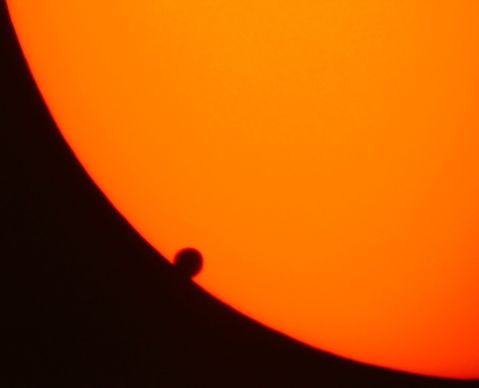 The black drop effect, photographed in 2004.
The black drop effect, photographed in 2004.
In 1874 several more expeditions set out, including several on Royal Navy Ships, such as HMS Volage, one of the largest mixed sail and steam ships ever built, which ferries the British expedition to the Kerguelen Island in the Southern Indian Ocean. Such measurements helped improve the distance measurement to 149.59+/-0.3 million kilometers. By 1881 it had been decided the distance to the Sun could be estimated better by other methods, although several expeditions still set out, and the first photographs of the transit were taken.
The current best distance to the Sun is 149.5978707 million kilometers, +/- 3 metres, measured using radar ranging to the inner planets. It’s known so accurately that we can measure it’s changing, growing about 15 metres every century.
The first transit of Venus to happen in the modern age was in 2004. You can find videos of this event (like the one below), which I was lucky to view from a small observatory near Ithaca, NY while I was studying for my PhD in Astronomy at Cornell University.
For the 2012 transit, apart from encouraging people to view the event as a last in your life time chance, there are couple of new developments. First smart phone technology which didn’t even exist in 2004 has allowed the development of a “Transit of Venus Ap“. In this Ap you can input the time you view the transit starting and/or ending, and participate in a global experiment to measure the distance to the Sun. Download the Ap in advance to practice inputing your measurement.
Interest in exoplanets has also significantly grown, including the signature that the atmospheres of those planets might have in the observed spectrum of a star when the planet is transiting. The Hubble Space Telescope will try to simulate this type of observation during the transit of Venus, observing the light from the Sun reflected by the Moon (if HST looked at the Sun it would be destroyed) to search for the signature of the atmosphere of Venus. You can read more about the plans on the NASA website.
Anyway I encourage you to get out there, or get online and view the last transit in our lifetime. Use the resources attransitofvenus.org, to work out the timings of the transit from your location, or search for local events. Other useful resources are the Royal Astronomical Society page on the Transit of Venus, in the UK, the HM Nautical Almanac Office. Also of possible interest, the Royal Observatory, Greenwich has a Venus Transit page, and a special (free) exhibit running until September 2012. And of course there’s a special Planethunters page on the transit too.
New Kepler Data: Feb 1
By Zak Kaplan (Yale undergrad)
Planet Hunters has just completed its first analysis of the Kepler data! With your classifications, we were able to extract information about all of the 150,000 light curves. We would like to thank the more than 16,000 registered users who have helped make Planet Hunters such a success. Special thanks to the collectors and the top 14 users who each analyzed over 5000 light curves, accounting for over 10% of the 1.3 million classifications.
To give a better idea of what you’re measuring in a transit curve, a planet crossing a star causes about the same dimming of light as a small fruit fly passing in front of a car headlight. Now imagine that car is a few thousand light-years away, and you get a sense of just how amazing the Kepler data and your work have been.
The Kepler team will have a press conference on 2 February 2011, announcing their new candidates and releasing new data that will more than quadruple the amount of data that we can serve to you. You can join the live broadcast on NASA TV at 1pm EST and we will post the Kepler press release here next Wednesday.
For the past week, the Exoplanet Research Team at Yale has been analyzing over 3500 light curves that you marked with promising transits. We found that PH users marked transits that we would have missed. From this first set of data, we have culled approximately 300 strong planet candidates, as well as several new eclipsing binary star systems. We are formatting the new Candidates pages now so that they will appear before the Kepler press conference. Then, you can check to see which objects you detected independently, before the Kepler team announced them. It will be especially interesting to see if there are some good candidates that you all found that are not on their new list. If so, we will ask the Kepler team for feedback on your new candidates.
We hope you will help continue to prove the power of citizen science, as we look for more planets beyond our solar system. Until then, keep on hunting!
Eclipsing binaries vs transits

It’s Christmas Eve and I’m starting a five-night observing run at the Keck Telescope using a high-resolution spectrograph (HIRES) to search for exoplanets. In the photo here, I am communicating with the telescope operator, Terry, by polycom. He is on the summit of Mauna Kea at 14,000 ft where the air is thin and I see that he has oxygen flowing. I’m glad that I’m working in comfort at Keck HQ in Waimea.
Tonight, I’m using the Doppler technique to measure the velocities of stars. Orbiting planets tug their host stars around a common center of mass. This reflex stellar velocity is largest for massive planets.
When small stars eclipse larger stars, the brightness dip can be virtually the same as those for transiting gas giant planets. To confirm a transit candidate as a planet, Doppler measurements are needed to determine the mass of the transiting object. The Kepler team has a massive follow-up campaign (led by Dr. Geoff Marcy at UC Berkeley) using the same setup that I’m using now. Dr. Natalie Batalha (Deputy Scientist for the Kepler project) explains that the team is also eager to have others helping and to have Planet Hunters combing through the data. Watch for a blog post by Dr. Batalha here soon!
Some of you have asked how many consecutive low points you should see during a transit. That depends on how close the planet is to the star. Close planets orbit faster and transit in a few hours while more distant planets take several hours to transit. You should look for more than one low point. Since the brightness measurements are taken every 30 minutes, a 3 hour transit would consist of just 6 low points. However the ingress, or first transit point, might be transitional and not reach the transit floor. Ditto for the egress, or last transit point).
The light curves for eclipsing binary stars are quite spectacular – they remind me of sketches I used to make with a “spirograph” toy I had as a kid. Some of the planet hunters have called this a shutter effect and I’ve written a quick program to demonstrate what is happening. In the Figure below, I created a theoretical light curve for a contact eclipsing binary with an orbital period of just 6 hours. If we had observations of this star every few minutes, then the light curve would look similar to a sine wave (left plot). However, if we observe this star less frequently (a slow “shutter speed”), then some interesting patterns emerge. The plot on the right in the Figure below shows an under-sampling of the light curve over 30 days. The pattern is similar to what appears in some of the eclipsing binary curves you are finding in the Kepler data.

Transiting Planets

Hi I’m Matt, a graduate student at Yale University and a member of the Science Team. We’re really impressed with the turnout so far on planethunters.org and users have already pointed out some really amazing objects! Quite a few people have asked for some clarification on what transits look like, so I’ll address that in this post.
In the figure above, we’ve taken a Kepler light curve from a star that’s about the same size as the Sun and have simulated what the effects would be if a few different types of planets were to transit.
The white dots show the amount of light from the star measured with Kepler with no planets transiting. The blue points show what we would see if a planet just like Jupiter orbiting this star were to transit. This Jupiter-size planet, at about 11.2 times the size of the Earth and one tenth the size of the star, is shown to scale transiting its parent star in the top left blue box.
The green dots show what a planet just like Neptune would look like transiting. Since it is much further away from the star than Jupiter, it would have a slower orbital speed so it would take longer to transit the disk of its parent star, which is what explains the longer duration, or wider width, of the transit event. With Neptune’s much smaller size than Jupiter, at 3.9 times the radius of the Earth, it doesn’t block out as much light, which is why the depth is much shallower.
Both of these events are very noticeable, compared to the effects of an Earth-size planet. The tiny speck on the star in the far right red box shows, to scale, what a transiting Earth-size planet would look like if we could see it. Now you get an idea of how difficult finding Earth-size planets is going to be! If that transiting planet had an orbital period of 1 year just like the Earth, then the dip in light observed from the parent star as the planet transits would be similar to the red points in the light curve. Since the Earth is much closer to the star, it has a much faster orbital speed, which then makes the duration of transit much shorter than the duration of either Jupiter or Neptune. Because the Earth-size planet is much smaller than either Jupiter or Neptune, it also blocks out less light making the dip in light we receive here on Earth barely discernible from no transit at all.
We don’t expect people to see these events all the time, so don’t worry about missing them. That’s why we’ve introduced fake planets into the mix. The fake, or synthetic, planets will help us determine the completeness of Planet Hunters, or how likely we are to detect planets of different sizes and with different orbital periods if they exist.

